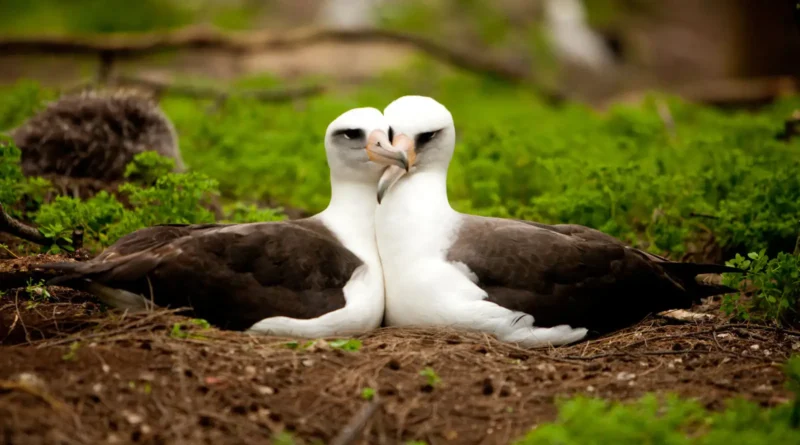Unveiling the Nesting Behavior of Albatrosses
I. Introduction
A. Overview of Albatrosses
Albatrosses are iconic seabirds known for their impressive wingspan and graceful flight over the open ocean. They belong to the family Diomedeidae and are renowned for their extensive migrations and lifelong partnerships.
B. Importance of Nesting Behavior
Nesting behavior is a crucial aspect of albatross biology, as it directly impacts their reproductive success and population dynamics. Understanding their nesting habits provides valuable insights into their life history and evolutionary adaptations.
C. Unique Aspects of Albatross Nesting
Albatross nesting behavior is unique among seabirds, characterized by long nesting periods, elaborate courtship rituals, and remote breeding sites on isolated islands.
II. Nest Site Selection and Establishment

A. Remote Breeding Sites
Albatrosses breed on remote islands and atolls, often far from mainland predators and human disturbances. These sites offer protection from terrestrial predators and abundant food sources in the surrounding ocean.
B. Courtship Displays and Pair Bonding
Courtship displays play a crucial role in pair bonding and mate selection among albatrosses. These displays involve intricate dances, bill clapping, and vocalizations, signaling readiness to mate and reinforcing pair bonds.
C. Nest Construction
Once pairs have formed, they begin the process of nest construction. Albatrosses typically build simple nests using grass, twigs, and other available materials, creating shallow depressions to cradle their eggs.
III. Egg Laying and Incubation
A. Timing of Egg Laying
Albatrosses exhibit synchronous breeding, with pairs laying a single egg per breeding season. Egg laying typically occurs in late fall or early winter, timed to coincide with optimal environmental conditions and food availability.
B. Incubation Duties
Both male and female albatrosses share incubation duties, taking turns to warm the egg and protect it from the elements. This cooperative behavior strengthens pair bonds and increases the chances of reproductive success.
C. Long Incubation Periods
Albatross eggs have long incubation periods, lasting anywhere from 65 to 80 days depending on the species. During this time, parents must remain vigilant and dedicated to ensuring the egg’s survival.
IV. Chick Rearing and Provisioning
A. Hatching and Chick Development
After hatching, albatross chicks require intensive care and provisioning from their parents. They are initially covered in downy feathers and are entirely dependent on their parents for food and warmth.
B. Provisioning Trips
Adult albatrosses undertake long foraging trips over vast ocean expanses to procure food for their chicks. These trips can last several days or even weeks, requiring considerable energy expenditure from the parents.
C. Parental Care and Protection
Parental care is critical during the chick-rearing phase, as chicks are vulnerable to predation and environmental stressors. Both parents work together to feed, protect, and nurture their offspring until they are ready to fledge.
V. Fledging and Juvenile Dispersal

A. Fledging
Albatross chicks fledge when they reach a certain size and developmental stage, usually around 5 to 6 months of age. Fledging involves leaving the nest and taking their first flight, a momentous occasion in the life of a young albatross.
B. Juvenile Dispersal
Once fledged, juvenile albatrosses undergo a period of juvenile dispersal, where they venture out into the open ocean and learn essential foraging and navigation skills. This phase is crucial for their survival and eventual return to breeding colonies.
C. Return to Breeding Colonies
After several years at sea, juvenile albatrosses return to their natal colonies to begin the cycle of courtship, nesting, and reproduction, thus perpetuating the legacy of their species.
VI. Conservation Implications
A. Threats to Albatross Nesting Sites
Albatross nesting sites face numerous threats, including habitat destruction, invasive species predation, and human disturbance. Conservation efforts are essential to mitigate these threats and ensure the long-term survival of albatross populations.
B. Climate Change and Nesting Success
Climate change poses additional challenges to albatross nesting success, with rising sea levels and extreme weather events impacting breeding colonies and food availability. Adaptation strategies are needed to help albatrosses cope with changing environmental conditions.
C. Community Engagement and Conservation
Community engagement and education play a vital role in albatross conservation, raising awareness about the importance of protecting nesting sites and reducing human impacts on seabird populations.
VII. Conclusion
Albatross nesting behavior is a marvel of evolutionary adaptation, characterized by elaborate courtship rituals, dedicated parental care, and remote breeding sites. By unraveling the mysteries of albatross nesting, we gain valuable insights into the complex web of relationships that sustain these magnificent seabirds. Through continued research, conservation efforts, and community engagement, we can ensure a bright future for albatross populations and the ecosystems they inhabit.

